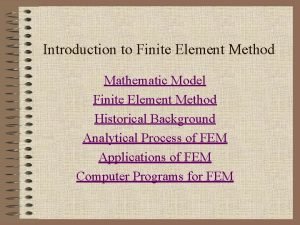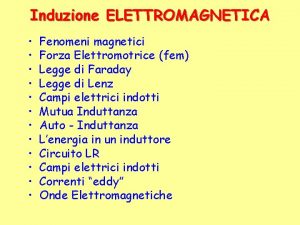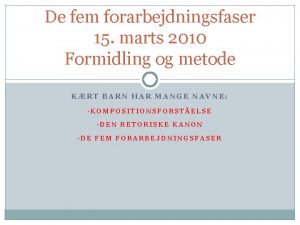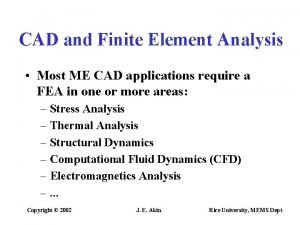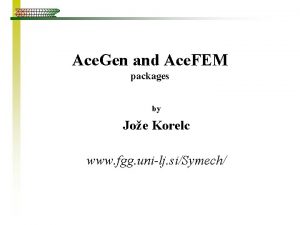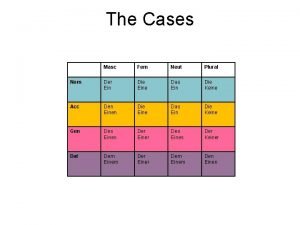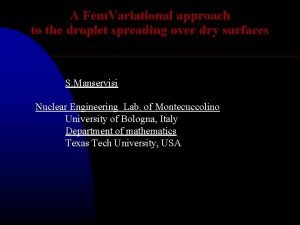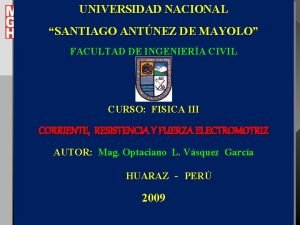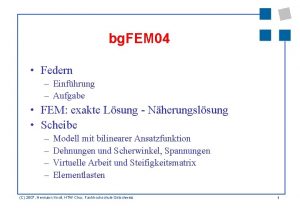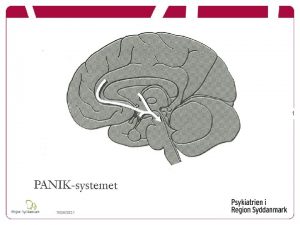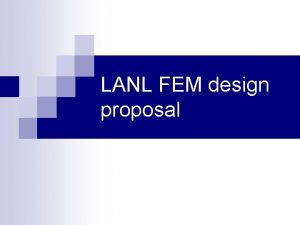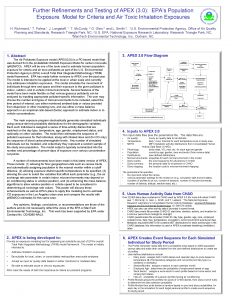Superconvergence and adaptive refinements in FEM Alexander Demidov





























- Slides: 29

Superconvergence and adaptive refinements in FEM Alexander Demidov St. Petersburg State University Applied and Computational Physics

�Finite elements method, main ideas �Superconvergence the derivative �Review in approximation of of adaptive refinements

Why we should speak about FEM? Nowadays it is one of the most powerful computational tools at our hands • Boundary conditions of different type • Easy accounting complex geometry of the object • Widely used Subject is developing and many important supplements are continuously appearing

History remarks Variational methods (Rayleigh 1870, Ritz 1909) Structural analogue substitution (Newmark 1949) Direct continuum elements (Argyris 1955, Terner et al. 1956) Weighted residuals (Galerkin 1915, Biezeno. Koch 1923) Piecewise continuous trial functions (Courant 1947, Zienkieviech 1964 ) Finite differences (Richardson 1910, Liebman 1918) Variational finite differences (Varga 1962) A present day Finite Elements Method

FEM. Main idea Replacement of the problem in the infinite dimensional space by finite analogue Consider linear differential operator

FEM. Subspaces One chooses a grid on Ω. It consists (in general) of some closed areas: in 2 D case it is triangles, squares or either curvilinear polygons.

Basic functions On each subdomain we can take some finite set of basis functions Normalized - Nodes of the element Corresponds to the order of approximation

Basis functions (2 D examples) quadratic cubic

Discretization Residual due to linearity of can be rewritten as: Constructing the linear algebraic system by weighting with

�Finite elements method, main ideas �Superconvergence effect in approximation of derivative �Review of adaptive refinements

Superconvergence. Problem definition Solution of a problem obtained by FEM If the highest power of basis function is n the error estimation will be following

Superconvergence. Problem definition For derivative of the solution Error estimation is Have we enough information to define more accurate ?

Superconvergence. The test problem The problem Parameters of the method n – number of basic functions m – number of finite elements 1) n = 2 (linear approximation), m = 2, 4 (number of finite elements) 2) n = 3 (quadratic approximation), m = 2, 4

1) exact solution and its derivative numeric solution and its derivative

2) exact solution and its derivative numeric solution and its derivative

Superconvergence effect (Barlow) Best accuracy of the FEM solution is obtainable for gradients at the Gauss points corresponding, in order, to the polynomial used in the solution Interpolating data, obtained in Gauss nodes (polynomial of corresponding degree)

Superconvergence effect. High dimensional elements Rectangles (parallelepipeds) – Cartesian product of the corresponding point on the line (plate) Triangles (tetrahedrons) – superconvergence points doesn't exist, but still there are some optimal sampling points

Superconvergence effect. High dimensional elements

Superconvergence effect. Algorithm Map Gauss-Legandre nodes at the finite element (Define points of superconvergence) Add to the superconvergence points some additional ones from neighbor elements Fit the obtained data in the list square sense

Superconvergence. Speed of convergence Parameters of the method: n = 4 (cubic approximation), p = 2 (number of additional points in superconvergence algorithm)

Superconvergence. Speed of convergence with different number of outer points

�Finite elements method, main ideas �Superconvergence effect in approximation of derivative �Review of adaptive refinements

Adaptive FE refinement. Main idea Adaptive refinement (depends on previous results) h-refinement q. Same type of elements q. Same type of basis functions q. Elements becomes smaller (larger) p-refinement q. Same size of elements q. Increases order of approximation functions (locally or throughout whole domain)

Adaptive FE refinement, h-refinement Element subdivision (enrichment) ü rather simple and widely used

Adaptive FE refinement, h-refinement Mesh regeneration; ü problem of transferring data ü results are generally much superior than in previous case

Adaptive FE refinement, h-refinement Reposition of the nodes ü difficult to use in practice

Conclusions � Sampling data in superconvergence points – way to improve accuracy of derivative of the FEM solution � Adaptive refinement of FEM mesh – way to improve accuracy of solution

References 1. 2. 3. Zienkiewicz O. C. , Taylor R. L. Vol. 1. The finite element method. The basis Chuanmiao Chen. Element analysis method and superconvergence Boyarshinov M. G. Computational methods. Part 3

 Mwacc
Mwacc Demidov family
Demidov family Violet plural
Violet plural Difference between fea and fem
Difference between fea and fem Difference between fea and fem
Difference between fea and fem Vad är ebp
Vad är ebp Fem teser om funksjonell respons på elevtekster
Fem teser om funksjonell respons på elevtekster Fem faste molde
Fem faste molde Advantedge fem
Advantedge fem Fem varför
Fem varför Retorikkens fem faser
Retorikkens fem faser Fem mesh
Fem mesh Motivationsorienteringer mette pless
Motivationsorienteringer mette pless Cirkelkomposition
Cirkelkomposition Fem applications
Fem applications Fem blv
Fem blv 5 punkts befaling eksempel
5 punkts befaling eksempel Grados de profesores
Grados de profesores De fem forarbejdningsfaser
De fem forarbejdningsfaser Formula fem pila
Formula fem pila Fem applications
Fem applications Fiskbensdiagram exempel
Fiskbensdiagram exempel Kilpatrick fem tråder
Kilpatrick fem tråder Netfem
Netfem Ace fem
Ace fem Masc/fem
Masc/fem 5 søyler islam
5 søyler islam Kilpatrick fem tråder
Kilpatrick fem tråder Variational approach in fem
Variational approach in fem Fem
Fem














